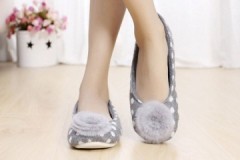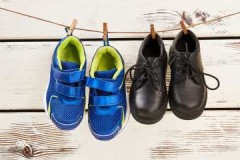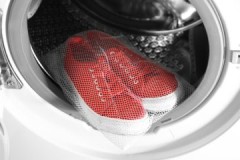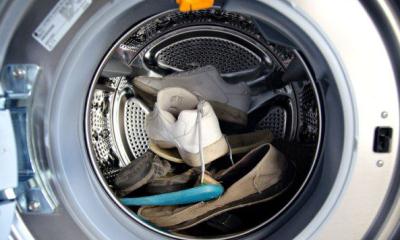 In the process of wearing, any shoes are not only subject to wear and tear, but also get dirty and lose their presentable appearance over time.
In the process of wearing, any shoes are not only subject to wear and tear, but also get dirty and lose their presentable appearance over time.
In addition, the inner side absorbs sweat and begins to emit an unpleasant odor. And the external one accumulates dust and dirt.
High-quality cleaning will help improve the condition of your shoes. But not every pair of shoes can be washed.
Is it possible and how to properly wash shoes (made of fabric, white, etc.) in an automatic washing machine and by hand? Read the article.
Content
Is it washable?
Manufacturers do not recommend washing most types and models of shoes, especially in a washing machine. Intense mechanical stress and moisture can lead to damage and deformation.
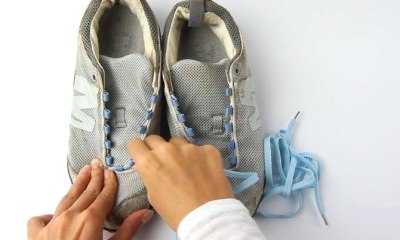 Before you start hand washing, and even more so machine washing, you need to:
Before you start hand washing, and even more so machine washing, you need to:
- Clean off adhering dirt and dust.
- Inspect for any defects requiring repair.
- Pull out the laces and removable insoles.
- If there are Velcro or zippers, they need to be fastened.
- If there are stains, they should be removed before the main wash.
Not every pair is washable. The following are prohibited:
- varnished;
- model;
- winter;
- designer with complex decor, etc.
Washing allowed:
- high-quality stitched sneakers made of leather and fabric;
- house slippers;
- sneakers;
- fabric sandals;
- fabric moccasins, etc.
More stringent requirements apply to shoes that are supposed to be machine washed. If you have doubts that sneakers or another pair will survive automatic washing, it is better to use manual cleaning.
Washing in an automatic washing machine
 Washing shoes by hand is a labor-intensive process. Responding to the wishes of consumers, many manufacturers of automatic washing machines have introduced the “Shoe Washing” mode.
Washing shoes by hand is a labor-intensive process. Responding to the wishes of consumers, many manufacturers of automatic washing machines have introduced the “Shoe Washing” mode.
Its feature:
- The washing process proceeds at low speed.
- Water heating temperature is limited.
- Drying and spinning are disabled.
But even with such a gentle effect, a negative result is possible. The following types are not subject to automatic washing:
- from leatherette;
- having fur inserts;
- suede;
- winter couples;
- having glued reflectors;
- things of very low quality;
- with the presence of permanent decor.
Preliminary cleaning of shoes from dirt before loading them into the machine is very important. In this case, it is necessary to thoroughly clean the top and sole, trying to remove as much as possible even small pebbles and grains of sand stuck in the sole, as they can damage the drum of the washing machine and lead to clogging.
At what temperature?
For shoes optimal temperature indicators – from +30? C to +40? C. A higher temperature may damage the product, while a lower temperature will be ineffective.
If the manufacturer does not specify a heating limit, it is better to limit it to +30? C.
In what mode, program?
It is best, if possible, to wash shoes in a specially designed mode. In this case, the temperature and duration of the wash will be automatically set.
If it is not available, you can select the most suitable option from those provided. Most suitable – delicate. It is adjusted in terms of temperature. And be sure to turn off the spin cycle.
Choosing a detergent
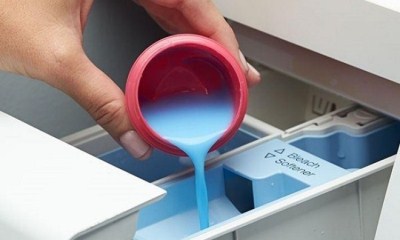 Shoes should be washed using detergent intended for automatic washing machines.
Shoes should be washed using detergent intended for automatic washing machines.
It is advisable to use products in gel rather than powder form. Liquid formulations dissolve better in water and do not form sediment.
The amount of detergent is determined in proportion to the machine load. If you are washing white sneakers, you can add oxygenated bleach without chlorine.
Do not add additional fabric softener as it may leave stains.
Why do you need a bag?
Sneakers or other shoes should be loaded into the drum special bag. Such mesh devices have compacted elements. They protect the drum from too intense impact, and the shoes from mechanical damage..
How many pairs at a time?
Each washing machine has a maximum load rating. But when washing shoes, this parameter does not matter, since You cannot wash more than two pairs at a time. This is a strict condition, violation of which can lead to equipment failure.
How to properly clean by hand?
You can wash sneakers and other shoes by hand that require more delicate care than an automatic machine provides.
For general cleaning you will need:
- the basin in which the washing will be carried out;
- warm water;
- brush for external cleaning;
- a brush with a long handle for cleaning the inside;
- rag or sponge;
- detergent.
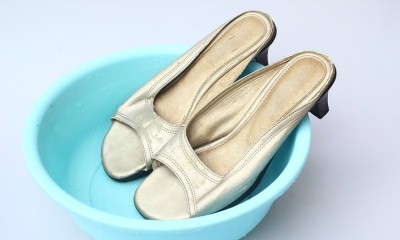 Work order:
Work order:
- Prepare shoes for washing.
- Pour water into the basin.
- Dilute detergent in water.
- Place the pair in water.
- Carry out sequential cleaning of the outer and inner parts.
- Rinse.
- Dry.
If the shoes are too dirty, the water needs to be changed during the washing process.
If the leather pair is not very dirty, you can limit yourself to shallow cleaning:
- treat only the outside of the shoes;
- wash insoles and laces.
How to dry?
After washing your shoes, you need to dry them. The best choice is in the air, at low humidity. There are many ways to deal with the problem quickly and easily.
You can find out more about drying rules Here.
Getting rid of complex dirt and odors
In some cases, simply washing your shoes is not enough. If there are stains on the surface of the material from grease, cat urine, etc., additional treatment is required. It will help eliminate the contamination itself and remove the unpleasant odor.
Fat
 These types of stains can remain on suede or fabric surfaces. Such problems do not arise with natural leather.
These types of stains can remain on suede or fabric surfaces. Such problems do not arise with natural leather.
To remove stains you will need:
- rags or napkin;
- purified gasoline or soap solution with ammonia (1:1);
- for suede – a special brush.
When removing stains, the following condition must be observed: do not over-wet the material, especially when it comes to suede.
Work order:
- Moisten a napkin in the prepared solution.
- Gently rub the stain.
- Dry the surface.
- After removing the stain, fabric shoes are washed, and suede shoes are cleaned with a special brush.
Biological and food stains
Food stains and biological stains (pet feces, blood) are quite difficult to remove. Leather shoes are the best to clean.
If the stain appeared as a result of the pranks of a pet, then in addition to eliminating the stain, you also need to neutralize the smell. For these purposes, an aqueous solution of hydrogen peroxide or vinegar is used. When mixing a solution of water, take 4 parts, and the active substance – 1 part.
Disinfectors from veterinary stores will help you cope with the smell from animal feces. But the use of products in this category can also leave stains. To prevent the spots from becoming even larger and more noticeable, before the first use, the new product should be tested on an inconspicuous area.
Reagents used by utilities in winter
In winter, utility workers sprinkle sidewalks and roads with special reagents, which help remove snow and ice. But for shoes, such substances often have a simply destructive effect.
 Washing is not always able to remove unsightly stains from skin. The following processing will help:
Washing is not always able to remove unsightly stains from skin. The following processing will help:
- Wipe the stains with ammonia (alternatively, vinegar diluted 1:3 with water).
- Blot the surface until it is completely dry.
- Lubricate with castor or other vegetable oil.
- Leave for a quarter of an hour.
- Use a soft cloth to remove excess treatment product.
Dye
You can remove paint stains by using solvent-based products. One option is to use ammonia solution. White alcohol or gasoline will have a similar effect.
Procedure:
- prepare a solution of 3 parts water and 1 part alcohol;
- Using a soft cloth soaked in the solution, carefully treat the surface.
Therefore, when using for the first time, it is recommended to carry out a test from the inside in an inconspicuous area.
Zelenka and iodine
 Remove green or iodine stains from leather shoes Alcohol or hydrogen peroxide will help.
Remove green or iodine stains from leather shoes Alcohol or hydrogen peroxide will help.
You can try to remove such preparations from a textile pair using a stain remover or ammonia.
If a difficult stain cannot be removed at home, you can turn to the services of a specialized shoe dry cleaner.
Processing depending on material and color
Taking into account the material from which the shoes are made, the approach to washing is determined. If there are 2 pairs in one load of the washing machine, they must be the same color.
White sneakers, sneakers and slippers can be washed with the addition of oxygen-containing bleach without chlorine. Black shoes can be washed using universal cleaning products or those designed for black items.In all cases, the liquid form, gel, is preferable.
From fabric
High-quality shoes made of fabric, for the most part, tolerate contact with water well. Cleaning with a dry brush will help remove dust.
Despite the fact that the material tolerates washing well (both automatic and manual), fabric shoes, like other shoes, should not be soaked for a long time and exposed to aggressive household chemicals (for example, bleach).
There are no special nuances with textiles when organizing washing. Subsequent proper drying - with good ventilation - will be extremely important.
Genuine Leather
 When natural leather gets wet, it becomes susceptible to external influences.
When natural leather gets wet, it becomes susceptible to external influences.
The washing process should not be long and repetitive. The impact should be delicate, intense friction should be excluded.
The tops of leather sneakers and sneakers can be cleaned well with soapy water and a brush. Open air is suitable for drying; electric dryers can also be used.
After washing and drying, it is advisable to treat natural leather with a special impregnation. You can find out more about washing leather shoes Here.
Artificial (leatherette)
The artificial material used for sewing shoes differs significantly from natural leather in its performance characteristics.
And requires specific care:
- Leatherette cannot be washed in an automatic machine, even on the most gentle programs.
- Do not use hot water.
- Do not brush vigorously.
- Do not use abrasive surfaces.
Nubuck and suede
 Materials such as suede and nubuck should not be over-wetted or washed vigorously.
Materials such as suede and nubuck should not be over-wetted or washed vigorously.
If cleaning agents must be used, they should be in liquid form and in low concentrations. After drying, the suede upper should be treated with a special brush and water-repellent spray..
Nubuck is even more difficult to care for than suede. When cleaning such shoes, it is advisable to avoid washing, limiting yourself to removing stains, if any, and dry cleaning.
Read about how to wash suede shoes in this article.
Work on mistakes
Mistakes made when washing and drying shoes very often lead to shoes becoming deformed and stains forming on them. Homemade recipes will help you cope with the problem.
Yellow spots
The following actions can lead to unsightly yellow spots and streaks:
- sun drying;
- poor rinsing, in which the detergent is not completely removed;
- wash in hot water.
Fabric sneakers and slippers will have to be washed:
- Pour cold water into the basin.
- Place your shoes in the water.
- Leave for 1 to 2 hours.
- Rinse well.
- Dry in a ventilated area or outside, but not in direct sunlight.
Loss of shape, formation of creases
If a fabric pair is deformed, the following actions will help restore its shape:
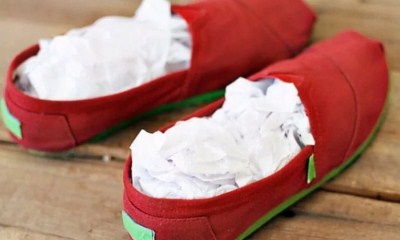 Pour water at room temperature into a basin.
Pour water at room temperature into a basin.- Wet your shoes.
- Remove from the basin.
- Drain off any remaining water.
- Blot the surface with rags or napkins.
- Carefully stuff the inside with paper that absorbs moisture well.
- As the paper becomes damp, replace it with dry paper.
To restore the shape of a leather pair, the following recipe will be useful:
- stuff the shoes with paper, giving them the required shape;
- lubricate the upper with shoe wax or cream;
- wait until the cream is absorbed;
- repeat the procedure 2 more times;
- collect the remaining product with a napkin;
- stand for a day without putting on shoes or removing paper.
You can eliminate serious deformations and creases in a leather pair by using the following recipe:
- Carefully stuff the shoes with paper, trying to form the desired shape.
- Wet the cloth and wring it out.
- Cover the prepared pair with a cloth.
- Wait until the skin is slightly moisturized.
- Set the iron to minimum setting, turning off the steam function.
- Carefully, working only through the fabric, iron the creases.
- If the result is not satisfactory, the process is repeated.
- Leave the shoes without removing the paper until completely dry and cool.
Increase or decrease size
If after washing the shoes have stretched and become larger, then it will not be easy to radically reduce them. The following techniques will help improve the situation:
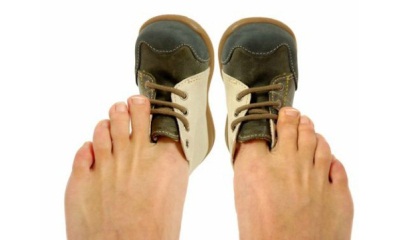 the use of additional silicone shoe inserts (they are sold in shoe departments of stores), as an option - a gel insole;
the use of additional silicone shoe inserts (they are sold in shoe departments of stores), as an option - a gel insole;- inserting small pieces of foam rubber into the toe area;
- Suede or leather shoes become smaller if you wet them and dry them again, but do not stuff them tightly with paper.
Even a repairman cannot reduce the size of textile shoes, but in some situations he can help with leather ones.
If fabric shoes shrink after washing, you can try stretching them. To do this, the pair is again moistened with water and tightly stuffed with paper, forming a shape. Additionally, you can use spacers, which are sometimes included when purchasing shoes.
For a leather pair, you can use this approach:
- Place inside a thick plastic bag without holes.
- Pour water into it.
- Place in the freezer.
- When water freezes, it will stretch the skin.
- Remove a couple from the freezer.
- As the ice begins to melt, it will shrink and the bag will be easy to remove.
- Dry the pair.
Scratches
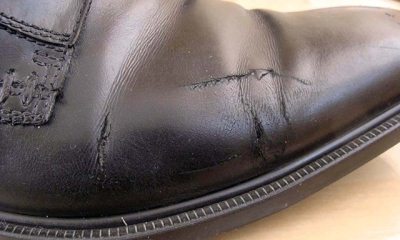 If washed incorrectly, scratches may appear on the leather surface. If they are shallow, then they can be tinted. Shoe polish of the appropriate color is suitable for this.
If washed incorrectly, scratches may appear on the leather surface. If they are shallow, then they can be tinted. Shoe polish of the appropriate color is suitable for this.
For deep scratches, wax will help:
- heat the wax (paraffin or beeswax);
- fill the scratch with it;
- wait until it cools completely;
- remove excess product with a soft cloth.
Recommendations
The following tips will help you wash your shoes by hand or using a washing machine:
- Without pre-treatment, shoes cannot be loaded into the drum of the machine.
- You should not put clothes in the same load as sneakers and sneakers, as things may become unusable after such treatment.
- After washing and drying, it is recommended to use shoe care products - use impregnations and creams for leather and suede, etc.
- Shoes of different colors should not be washed at the same time due to the risk of color transfer.
- It is advisable to wash insoles and laces more often than washing the entire pair.
- Minor stains on the outside can be removed without a full wash.
- It is recommended to avoid prolonged soaking and prolonged contact with water.
You will find maximum useful information about washing clothes and various fabric products Here.
Conclusion
Proper washing and drying of shoes will help keep them in good condition and clean.. To do this, you need to follow the recommendations of specialists and do not wash shoes for which such treatment is prohibited.
